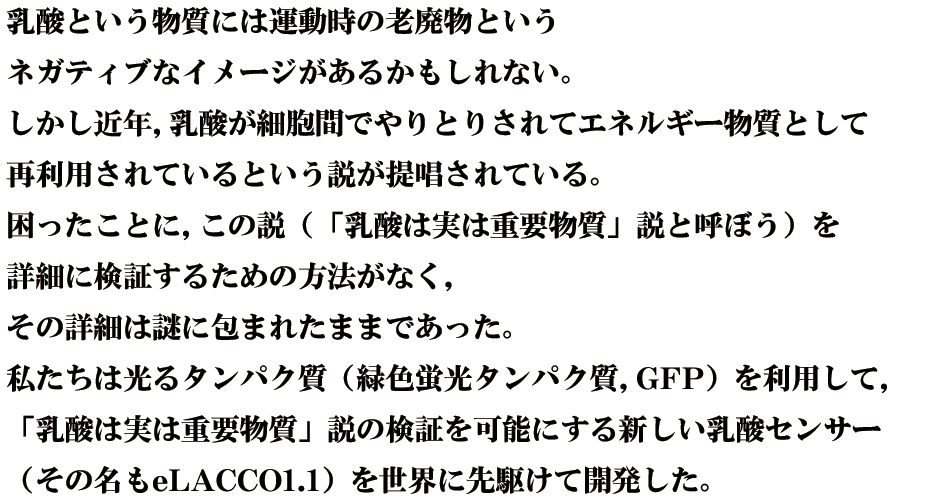Disclaimer: machine translated by DeepL which may contain errors.
Lactic Acid is Actually an Important Substance - Development of Lactate Sensor
Yusuke Nasu, Assistant Professor, Department of ChemistryRobert E. Campbell, Professor, Department of Chemistry |

![]()
Living organisms, including human beings, maintain their individual activities as an aggregate of cells by supplying energy necessary for the activities of each cell (muscle cells, nerve cells, etc.) through cell-to-cell transfer of energy obtained from external sources such as food. For a long time, glucose, familiarly known as glucose, was considered to be the major intercellular energy transmitter, and lactate was considered to be a simple metabolic byproduct of glucose. This negative view of lactate is still prevalent in the general public, in large part due to the classical findings in sports science regarding the relationship between lactate and fatigue. Recently, however, a theory that lactate is exchanged between cells and reused as an energy substance ("lactate is actually an important substance" theory) has been proposed, and the role of lactate is being reconsidered. To verify this "lactate is actually an important substance" theory, it is necessary to observe the movement of lactate between cells. However, there is no method to do so, and it has been difficult to verify the "lactate is actually an important substance" theory.
Since lactic acid itself has neither color nor coloration, we cannot observe the movement of lactic acid in vivo as it is. However, if we could develop a sensor that glows in response to lactate, we would be able to observe the movement of lactate in real time. Therefore, we fused a green-lighting protein (GFP) and a lactate-binding protein (TTHA0766), and made many modifications by protein engineering. As a result, we succeeded in developing a lactate sensor, eLACCO1.1, which changes its green light intensity in a lactate concentration-dependent manner (upper figure). eLACCO1.1 is capable of lactate observation in various mammalian tissues (lower figure).
Some readers may have been told to consume sugar when studying. This is based on the idea that nerve cells (neurons) in the brain use sugar (glucose) for energy needed for their activities. However, according to the "lactate is actually an important substance" theory, neurons receive lactate secreted by other cells as their main source of energy. This theory overturns the conventional wisdom. From now on, should we take lactic acid when we study? It is expected that our lactate sensor eLACCO1.1 will contribute to the clarification of the theory that "lactate is actually an important substance" and rewrite the common knowledge in metabolic science textbooks centering on glucose.
This research result was published in Nature Communications 12, 7058 (2021) by Y. Nasu et al.
(Press release, December 6, 2021)
Published in the March 2022 issue of Faculty of Science News
Communicating to Faculty Research Students >



